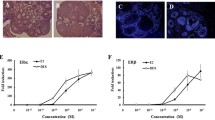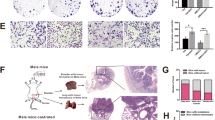Abstract
The etiology of testicular dysgenesis syndrome is multifactorial and involves environmental factors, such as environmental estrogens. Several studies have shown that hormonal effects on the gubernaculum may affect testicular descent. Diethylstilbestrol (DES) is a nonsteroidal synthetic estrogen that disrupts the morphology and proliferation of gubernacular cells, but the underlying mechanisms remain elusive. In this study, we aimed to determine whether DES may regulate the function of gubernaculum testis cells by way of nongenomic effects mediated by G protein-coupled estrogen receptor (GPER). We used cultured mouse gubernacular testis cells to demonstrate that GPER is expressed in gubernaculum testis cells. Erk1/2 inhibitor PD98059, PKA inhibitor H89, and Src inhibitor PP2 relieved DES-induced inhibition of gubernaculum testis cell proliferation, but ER inhibitor ICI 182780 had no effects on DES-induced inhibition of gubernaculum testis cell proliferation. In addition, we found that DES induced the activation of CREB downstream of PKA, Src, and ERK1/2 in these cells. These data suggest that the effects of DES on mouse gubernaculum testis cells are mediated at least partially by GPER–protein kinase A–ERK–CREB signaling pathway.




Similar content being viewed by others
References
Bartlett JE, Washburn T, Eddy EM, Korach KS, Temelcos C, Hutson JM (2001) Early development of the gubernaculum and cremaster sac in estrogen receptor knockout mice. Urol Res 29:163–167
Cederroth CR, Schaad O, Descombes P, Chambon P, Vassalli JD, Nef S (2007) Estrogen receptor alpha is a major contributor to estrogen-mediated fetal testis dysgenesis and cryptorchidism. Endocrinology 148:5507–5519
Costa WS, Sampaio FJ, Favorito LA, Cardoso LE (2002) Testicular migration: remodeling of connective tissue and muscle cells in human gubernaculum testis. J Urol 167:2171–2176
Giwercman A (2011) Estrogens and phytoestrogens in male infertility. Curr Opin Urol 21:519–526
Hutson JM, Sasaki Y, Huynh J, Yong E, Ting A (2004) The gubernaculum in testicular descent and cryptorchidism. Turk J Pediatr 46:3–6
Jiang XW, Li JH, Huang TH, Deng WD (2004) Effect of prenatal exposure to diethylstilbestrol on gubernacular development in fetal male mice. Asian J Androl 6:325–329
Leonardi MO, Puchi M, Bustos P, Romo X, Morín V (2012) Vitellogenin induction and reproductive status in wild Chilean flounder Paralichthys adspersus (Steindachner, 1867) as biomarkers of endocrine disruption along the marine coast of the South Pacific. Arch Environ Contam Toxicol 62:314–322
McKinnell C, Sharpe RM, Mahood K, Hallmark N, Scott H, Ivell R et al (2005) Expression of insulin-like factor 3 protein in the rat testis during fetal and postnatal development and in relation to cryptorchidism induced by in utero exposure to di (n-butyl) phthalate. Endocrinology 146:4536–4544
Meyer MR, Haas E, Prossnitz ER, Barton M (2009) Nongenomic regulation of vascular cell function and growth by estrogen. Mol Cell Endocrinol 308:9–16
Newbold RR, Jefferson WN, Padilla-Banks E, Haseman J (2004) Developmental exposure to diethylstilbestrol (DES) alters uterine response to estrogens in prepubescent mice: low versus high dose effects. Reprod Toxicol 18:399–406
Newbold RR, Padilla-Banks E, Jefferson WN (2006) Adverse effects of the model environmental estrogen diethylstilbestrol are transmitted to subsequent generations. Endocrinology 147:S11–S17
Rago V, Romeo F, Giordano F, Maggiolini M, Carpino A (2011) Identification of the estrogen receptor GPER in neoplastic and nonneoplastic human testes. Reprod Biol Endocrinol 9:135
Silva E, Kabil A, Kortenkamp A (2010) Cross-talk between nongenomic and genomic signalling pathways—distinct effect profiles of environmental estrogens. Toxicol Appl Pharmacol 245:160–170
Skakkebaek NE, Rajpert-De Meyts E, Main KM (2001) Testicular dysgenesis syndrome: an increasingly common developmental disorder with environmental aspects. Hum Reprod 16:972–978
Soito IC, Favorito LA, Costa WS, Sampaio FJ, Cardoso LE (2011) Extracellular matrix remodeling in the human gubernaculum during fetal testicular descent and in cryptorchidic children. World J Urol 29:535–540
Staub C, Rauch M, Ferrière F, Trépos M, Dorval-Coiffec I, Saunders PT et al (2005) Expression of estrogen receptor ESR1 and its 46-kDa variant in the gubernaculum testis. Biol Reprod 73:703–712
Toppari J, Virtanen HE, Main KM, Skakkebaek NE (2010) Cryptorchidism and hypospadias as a sign of testicular dysgenesis syndrome (TDS): environmental connection. Birth Defects Res A 88:910–919
Wallacides A, Chesnel A, Ajj H, Chillet M, Flament S, Dumond H (2012) Estrogens promote proliferation of the seminoma-like TCam-2 cell line through a GPER-dependent ERα36 induction. Mol Cell Endocrinol 350:61–71
Zhang X, Li JH, Ma L, Huang TH, Jiang XW (2012) Diethylstilbestrol impairs the morphology and function of mouse gubernaculum testis in culture. Cell Biol Toxicol 28:397–407
Acknowledgments
This study was supported by a grant from National Natural Science Foundation of China (811705551) and a grant from the Scientific Research Foundation for the Returned Overseas Chinese Scholars, State Education Ministry.
Author information
Authors and Affiliations
Corresponding author
Rights and permissions
About this article
Cite this article
Zhang, X., Li, Jh., Duan, Sx. et al. G Protein-Coupled Estrogen Receptor–Protein Kinase A–ERK–CREB Signaling Pathway is Involved in the Regulation of Mouse Gubernaculum Testis Cells by Diethylstilbestrol. Arch Environ Contam Toxicol 67, 97–103 (2014). https://doi.org/10.1007/s00244-013-9976-3
Received:
Accepted:
Published:
Issue Date:
DOI: https://doi.org/10.1007/s00244-013-9976-3




